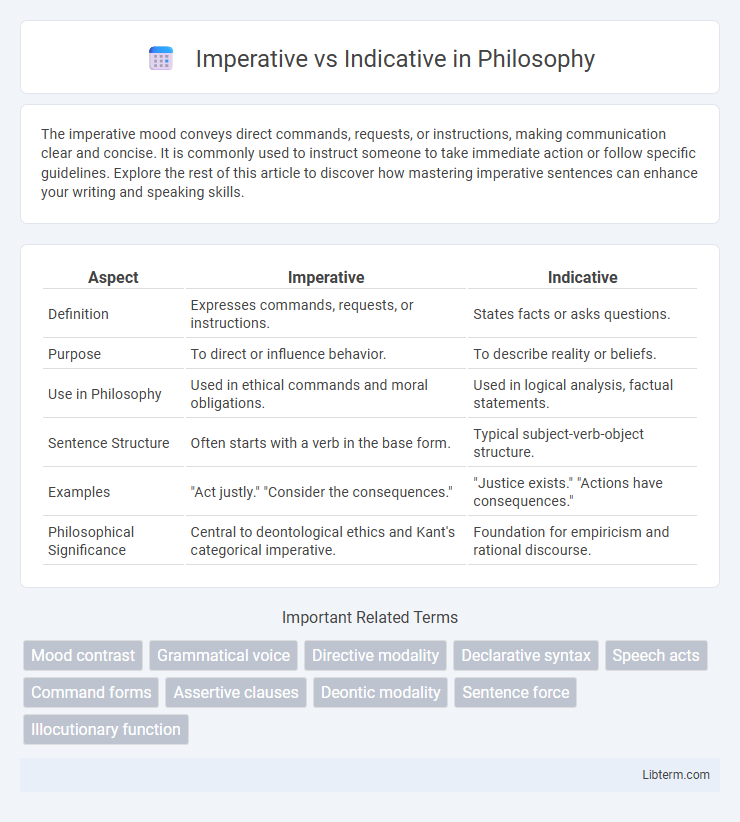The imperative mood conveys direct commands, requests, or instructions, making communication clear and concise. It is commonly used to instruct someone to take immediate action or follow specific guidelines. Explore the rest of this article to discover how mastering imperative sentences can enhance your writing and speaking skills.
Table of Comparison
| Aspect | Imperative | Indicative |
|---|---|---|
| Definition | Expresses commands, requests, or instructions. | States facts or asks questions. |
| Purpose | To direct or influence behavior. | To describe reality or beliefs. |
| Use in Philosophy | Used in ethical commands and moral obligations. | Used in logical analysis, factual statements. |
| Sentence Structure | Often starts with a verb in the base form. | Typical subject-verb-object structure. |
| Examples | "Act justly." "Consider the consequences." | "Justice exists." "Actions have consequences." |
| Philosophical Significance | Central to deontological ethics and Kant's categorical imperative. | Foundation for empiricism and rational discourse. |
Understanding Imperative and Indicative: Definitions
The imperative mood expresses commands, requests, or instructions, directly addressing the listener and often omitting the subject "you." The indicative mood conveys factual statements, descriptions, or questions, representing reality or certainty. Understanding these moods is essential for clear communication and accurate sentence construction in English grammar.
Key Differences Between Imperative and Indicative
The imperative mood issues commands, requests, or instructions, directly addressing the listener with verbs in their base form, while the indicative mood states facts, asks questions, or expresses opinions using verbs that reflect time and reality. Imperative sentences often omit the subject because it is understood to be "you," whereas indicative sentences explicitly include the subject. The imperative is used for actions to be performed, and the indicative is used for describing actions or conditions as part of everyday communication.
Grammatical Structures of Imperative and Indicative
The grammatical structure of the imperative mood typically features the base form of the verb without a subject, as the subject "you" is implied, such as "Close the door." In contrast, the indicative mood uses a complete sentence structure with a subject and a conjugated verb to express statements or ask questions, for example, "She closes the door" or "Does she close the door?" Imperative sentences often contain verb phrases that command, request, or instruct, while indicative sentences focus on declarative or interrogative verb forms conveying facts or inquiries.
Common Uses of the Imperative Mood
The imperative mood is primarily used for commands, requests, and instructions, directly addressing the listener to perform an action. Common examples include directives like "Close the door," "Please submit the report," and "Turn left at the intersection." Unlike the indicative mood, which states facts or asks questions, the imperative mood emphasizes urgency and immediacy in communication.
Practical Applications of the Indicative Mood
The indicative mood is primarily used for stating facts, asking questions, and expressing opinions or beliefs, making it essential in everyday communication and formal writing. Practical applications of the indicative mood include delivering clear instructions, reporting events, and providing information in news articles, academic papers, and business communications. Mastery of the indicative mood enhances clarity and precision in both spoken and written language, facilitating effective knowledge transfer.
Examples of Imperative Sentences
Imperative sentences give direct commands, requests, or instructions, such as "Close the door," "Please read the report," and "Turn off the lights." These sentences often omit the subject "you," which is understood by the context. Examples highlight their use in everyday communication for urgent or important actions.
Examples of Indicative Sentences
Indicative sentences convey facts, descriptions, or statements of reality, such as "She walks to school every day," "The sun sets in the west," and "They finished the project on time." These sentences use the indicative mood to express certainty and objective information. Examples highlight simple present, past, and future tenses within the indicative form.
Imperative vs Indicative in Different Languages
The imperative mood, used for commands or requests, varies significantly across languages in its formation and usage compared to the indicative mood, which expresses statements or facts. In Romance languages like Spanish and French, the imperative often omits the subject pronoun, while the indicative maintains explicit subject forms, highlighting mood distinction through verb conjugation patterns. In contrast, East Asian languages such as Japanese use distinct sentence-ending particles to differentiate imperative commands from indicative statements, emphasizing context and politeness levels rather than morphological changes.
Common Mistakes and Misconceptions
Confusing the imperative mood with the indicative often leads to errors in tone and intent, such as using the indicative form when issuing direct commands or requests. A common mistake is failing to recognize that the imperative lacks a stated subject, while the indicative explicitly presents the subject and verb to express facts or questions. Misconceptions include believing imperatives are only for harsh commands, ignoring their polite forms in everyday speech and writing.
Tips for Using Imperative and Indicative Correctly
Use the imperative mood to directly issue commands, requests, or instructions, with verbs typically starting in their base form, such as "Close the door" or "Please sit down." Employ the indicative mood to state facts, describe reality, or ask questions, like "She walks to school" or "Are you coming?" Always ensure the verb form matches the intended mood to avoid confusion, and remember that the imperative often omits the subject "you," while the indicative explicitly includes it or implies it through conjugation.
Imperative Infographic

 libterm.com
libterm.com